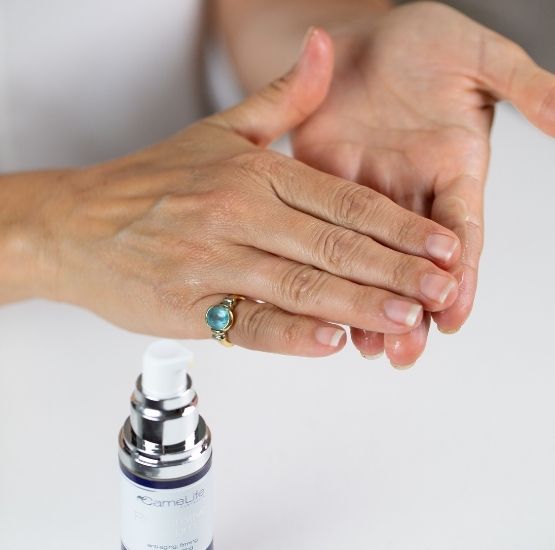We're Talking Serums
Buy NowLet's Talk About Serums
So What Is A Serum?

But what is a serum? I ask this question because only this week I was chatting to a customer who works in the skincare industry. Even she was confused about the difference between serums, day creams and night creams. And what does it do, how should it feel and will it sting?
Next, how do you use a serum? How it should fit into your daily skincare regime. Do you use it before, or instead of, a moisturiser? Do you use it daily, or less frequently?
It's all a bit confusing. No wonder; serums are moisturising, but you still need a moisturiser. Serums can be oily, but they’re not face oils. Serums can be watery, but they're not toners. Some serums come in dropper bottles and look rather "medical", others are more like a cream.
There are so many questions and we haven’t even started on the ingredients, let alone discussed why camel milk makes a great base for a serum! So let's de-mystify serums and find out what is so special about CameLife's Restorative Serum.
First A Definition
Let's start at the start and answer, what is a facial serum? Our starter for ten; a serum is skincare product that you apply to your face after cleansing but before moisturising. It's designed to deliver powerful ingredients directly into the skin.
So serums are light, fast-absorbing liquids used made from smaller molecules that can penetrate deeply into the skin and deliver a very high concentration of active ingredients. This makes them a great tool for targeting you specific skincare concerns, like wrinkles and blemishes.

What Should A Serum Feel Like?

Your serum should apply easily and feel lightweight, even though the formula is packed with the best of the best ingredients. After application, your skin should feel silky smooth, with no oily residue remaining on the surface. Serums typically have a distinguishing smooth delicate feel and a silky fluid texture. A good way to test a serum is to apply a small drop of a serum to the back of your hand and gently rub it in. You should see and feel it spread easily and absorb quickly with no stinging or burning sensation.
Your skin should not feel oily or greasy; serums should not contain occlusive ingredients such as petroleum jelly or mineral oil that keep water from evaporating. They also contain fewer lubricating and thickening agents, like nut or seed oils. Indeed, many serums are water-based, eliminating oils altogether. So if a serum feels oily, it's not really a serum!
Typical Serum Ingredients
- Antioxidants that protect against photo-ageing and fight the damaging free radicals responsible for destroying your collagen. Vitamin C is a great anti-oxidant, which is why you see Vitamin C Serums.
- Anti-inflammatories such as zinc, arnica, aloe vera and goldenseal, which can neutralise redness and prevent inflammatory cell damage.
- Hydrators such as ceramides, amino acids and essential fatty acids that strengthen your skin’s barrier and help build strong cell membranes. These ingredients protect against dryness and fine lines by replenishing naturally occurring skin lipids, improving moisture retention and protecting skin from the environment.
- Hydrolysed soy, a great source of isoflavones, which appear to protect the skin against hormone-related ageing, such as menopause. Isoflavones have oestrogenic activity and can compensate for declining oestrogen levels by binding to the same receptor sites. Hydrolysed soy protein helps bring back a youthful radiance in skin care.
- Hyaluronic acid to help control your skin's moisture levels. If your skin is so dry that your are having to apply a moisturiser during the day, then you probably need to increase your skin's hyaluronic acid levels.
- Retinol, a form of Vitamin A, which helps to neutralise free radicals and boosts collagen and elastin production. The effect is plumping, with fewer fine lines, wrinkles, and enlarged pores. Retinol is also a mild exfoliant, further improving texture and tone.

Using a Serum

One of the most common questions we are asked is 'do I use both a serum and a moisturiser'. Like most skincare questions, the answer is “maybe”; it really depends on your skincare needs. A good serum should restore, revive and renew, your skin, fortifying the lower layers to make it feel and look healthier.
- If your is showing few signs of ageing, just following the basic steps of cleansing and moisturising is usually enough as a daily routine. Use a serum maybe once a week or so to keep it looking young.
- If you have early signs of skin ageing, you should benefit from a more advanced skincare routine that include a serum. Use your serum once a day, between cleansing and applying your day cream in the morning.
- More advanced signs of ageing need more loving! Deeper wrinkles, uneven skin tone, dry patches and rough texture all need treatment. An intense period of applying serum twice a day should produce results. During this period, it's best not to apply a night cream after your serum.
- If you have oily skin, a serum which contains hyaluronic acid can be great because they leave little emollient residue.
Sensitive Skin
The highly concentrated ingredients in serums can sometimes be too potent for sensitive skin; they may actually penetrate too quickly, causing irritation. Eczema and rosacea sufferers are often advised to avoid serums, whilst there are specific acne treatment serums on the market.
CameLife’s Restorative Serum contains camomile essential oil for its calming properties, whilst the camel milk’s bio-active ingredients help to moderate irritation at source.
Acne sufferers are finding that CameLife’s Restorative Serum doesn’t sting or irritate and that it is highly nourishing for skin that has been damaged by conventional acne treatments that contain benzyl peroxide and synthetic retinol, both of which dehydrate and thin the skin.

Camel Milk Serums

Camel milk is a great serum base, because it has a very finely homogenised fat structure. The milk can naturally penetrate deep into your skin, carrying ingredients where they are needed. When you drink camel milk, it feels silky smooth on the tongue because the fats are so homogenised. You feel the same on your skin.
There is plenty of Vitamin C in a very bio-available form in the milk, providing that key anti-oxidant effect required of a serum. On its own, camel milk has a powerful anti-inflammatory effect, because the protective proteins in the milk help to modulate the immune reactions that cause inflammation at source.
The milk is packed with Omega fatty acids, so its very hydrating. And it contains lactic acid, a natural humectant that draws water from the base layers of your skin towards the surface. All that before we start adding other ingredients!
A Great Offer on CameLife Restorative Serum
We really want you to try Restorative Serum and experience just how good it is. You won't buy another; it really is the best! So we've got a great offer; GET YOUR FIRST SERUM FOR JUST $40 INCLUDING POSTAGE!
In fact, we're so confident that you will love your Restorative Serum that we offer an unequivocal money back guarantee if you are in any way unhappy with your product.






